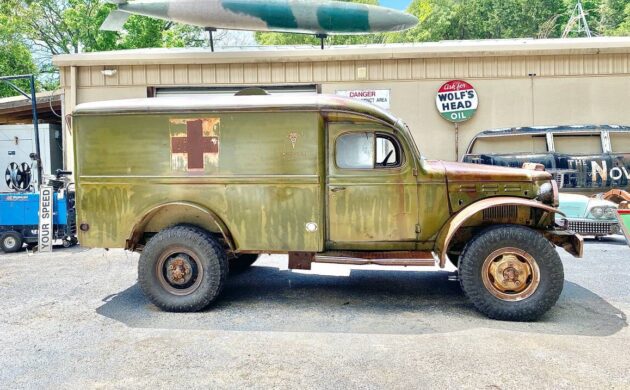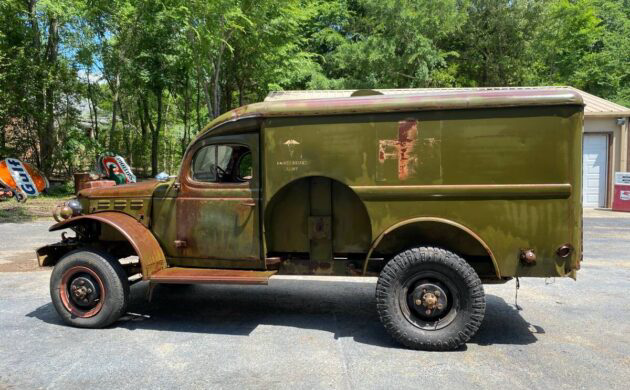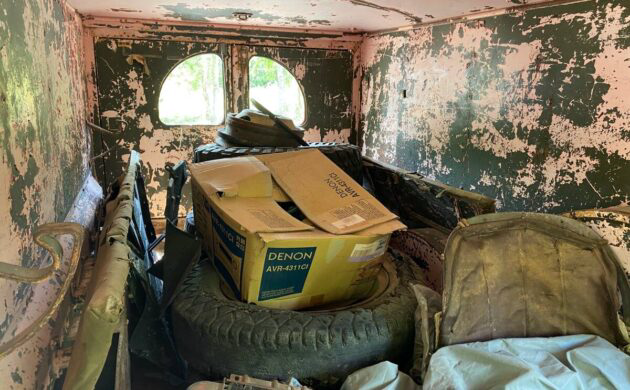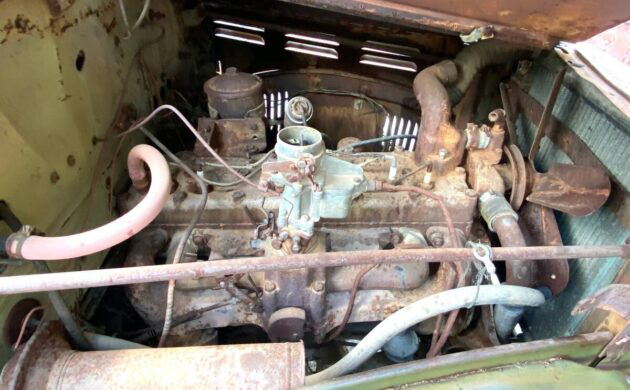Amazing 1945 Dodge WC-54 Ambulance
“Amateurs study tactics; professionals study logistics.” This is a quote that, with a few changes here and there, that has been around for a long time and attributed to leaders such as Napoleon and Omar Bradley. In World War II, the United States not only mechanized the whole of our armed forces, but, through Lend-Lease and other programs, we made this possible for our allies as well. One example of the many mechanical marvels that won the war would be this 1945 Dodge WC-54 ambulance for sale on craigslist in Athens, Texas. Vehicles such as this ambulance made the concept of total war possible and gave soldiers the confidence of knowing they would be taken care of. With a $17,500 price tag, is this a World War II project you would like to take on? Thanks go to T.J. for the tip!
History books don’t do our role in World War II justice. Sure, the United States fought many courageous battles in the sea, on land, and in the air during the course of the hostilities. A lot of great people sacrificed the rest of their lives to win that war. Just imagine all that those people could have accomplished had they not been placed in the unenviable position of going to war. Imagine how they and their potential offspring could have changed the trajectory of this country for the better. Also, think of those who did return, but did not return whole and what they gave up for our freedom. When you think of the downstream effects of having to fight against tyranny, greed, and insanity, it is obvious that this country owes the people of that generation more than can be calculated. We simply can’t fathom a world where so much was lost with our 21st century worldview.
One lesson that seems to have been lost in the decades since is the concept of total war. Once war was declared, the plan was clear: total victory over the Axis powers. It would take an all-out effort from everyone in society, from kids collecting metal for scrap drives, women breaking tradition and working in factories, and men leaving home for the first time to face a high likelihood of never seeing their front door again. These were just a few examples of the sacrifices made. The war drug on from December 7, 1941, through September 2, 1945, when the Japanese surrender document was signed on the decks of the USS Missouri. It is hard to believe that a population could endure such sacrifice over such a long period with just newspapers and radio delivering basic news, often days late, and families all dreading a knock at the door or a ringing of the doorbell.
Yet it was that concept of total war that carried the day. Insulated by two oceans, the might of American industry, from mining to manufacturing, began to produce not just the obvious weapons of war like guns, tanks, and airplanes. America built up the incredible infrastructure that allowed American and Allied forces to bring the fight to the enemy and sustain that fight. Just ask the Germans how Operation Barbarossa went without the proper supply chain to sustain combat operations when winter set in. You might also want to ask how using horses for transportation worked out when they themselves demonstrated the power of the Blitzkrieg at the beginning of hostilities.
It was the logistical necessities of war like this 1945 Dodge WC-54 ambulance that made pushing the total war concept possible. Built partly from the metal collected in scrap drives, assembled by men and women who were supporting the war from the home front, and driven by brave folks who risked their lives to help the wounded and give both them and the other soldiers hope on the battlefield if they were injured, ambulances like this one helped to keep pressure on the enemy. It was that unrelenting pressure that ultimately exhausted our enemies and their will to fight. It had to have been flat demoralizing to see Americans pressing the war against you when most of your friends are gone, your clothes are worn out, and you feel lucky to have for dinner a piece of the horse that was pulling a piece of artillery just a few days ago.
So, why own a vehicle like this ambulance? The America of today needs to have a better handle on just what sacrifices were made to allow them to live as they do today. Tanks and such are neat, but an ambulance like this presents to them a very personal aspect of warfare: the care of the wounded. These vehicles could carry up to four patients at a time to the rear for a chance at survival. You cannot look into the back of this vehicle and not have some tinge of understanding of the soldier’s experience. Restored, this vehicle tells the story of a desperate part of war that needs no interpretation.
As for this particular ambulance, it is described as very original and complete. It is also extremely rust free, considering that many of its fellow ambulances long ago succumbed to rust. It currently does not run, and the ad neglected to say if the engine will turn over. Even if it will not, there are still a lot of WWII surplus parts out there. You can even buy a lot of parts at your local NAPA, for these engines lived on into the seventies in agricultural pumps and aircraft tugs. This ambulance won’t be the fastest vehicle in your collection, but it will likely go anywhere you want to take it. The hard part of its life has already been lived, and it has gone places I hope we never have to go again.
Do you have stories of family and friends during World War II and the sacrifices they made for us. If so, please share them in the comments.
Auctions Ending Soon
 2002 Subaru Impreza WRXBid Now2 days$333
2002 Subaru Impreza WRXBid Now2 days$333
 1975 Chevrolet Corvette ConvertibleBid Now3 days$4,000
1975 Chevrolet Corvette ConvertibleBid Now3 days$4,000
 1964 Ford F-100 Camper CustomBid Now3 days$2,000
1964 Ford F-100 Camper CustomBid Now3 days$2,000
 2006 Jeep Wrangler SportBid Now4 days$10,500
2006 Jeep Wrangler SportBid Now4 days$10,500
 1974 Datsun 260ZBid Now6 days$200
1974 Datsun 260ZBid Now6 days$200







Comments
Very much appreciate the direction you took in writing with this, Jeff-right on the point.
If this had almost any other body it’d already be gone at this price! As has been said time and again, after the Apocalypse the only thing still moving will be these Power Wagons (M37’s included) and cockroaches.
Well said, Jeff. I’d like to take it a little further and say that the sacrifices weren’t just on our side; the enemy also had its share. I have a copy of a book titled, “A Higher Call,” which is a true story about a B-17 bomber crew that was trying desperately to get their shell shattered plane and injured crew out of Germany and back to Britain. A BF109 pilot saw them and despite being duty-bound to shoot it down, after seeing how helpless the bomber was, he escorted it out of Germany and let it go. The two pilots never forgot that and managed to meet up nearly 40 years later. There’s compassion on both sides. Yes, this truck is a great reminder of war and it will help us to remember that war is hell.
Other than that, I would love to have a truck like this at my place. I would fix it up, make sure all the wheels and tires were the same and I’d put it to work, serving another purpose. For me part of remembering the sacrifices is driving one of the vehicles and in keeping it alive it keeps the memories alive. I will think of my Dad who served on a destroyer, and my uncle who was a navigator on a bomber and was shot down over France and taken prisoner. Of course you cannot forget Korea, Vietnam, the Gulf War or the crap in Iraq and Afghanistan…https://www.youtube.com/watch?v=_8EkmyoG83Q
A good book, Geomechs and as an interesting aside: they met in part because of a Swedish rock and roll band (Sabaton) that had set the story to music.The German grandson had heard the story and after hearing the song on the radio went with his mother to their concert. They two pilots were brought together where they finally met face to face and became close friends living in Canada near each other.
Thanks Geomechs for that story – after all we all are humans – and many sacrifices are forgotten today cause they aren’t told in the schoolbooks – like for example the sacrifices of the sovjets, quote:
“The Soviet Union lost around 27 million people during the war, including 8.7 million military and 19 million civilian deaths. The largest portion of military dead were 5.7 million ethnic Russians, followed by 1.3 million ethnic Ukrainians. A quarter of the people in the Soviet Union were wounded or killed. ” –
Wow,, I thought maybe I was the only one who won’t forget our past. Comes up on every military Jeep. While the WW2 reference is noble, and not to be a wet blanket, but if this truck is a 1945, it was probably a surplus and never shipped. Anything that served in the war, either stayed there or was dumped at sea. Fact is, I don’t see any military markings and here’s a great photo of what we did to win the war. Overwhelm the enemy with numbers, and it worked, at such a cost. To quote one of the most influential songs of my time, Edwin Starr ” War, huh, good God, y’all,, what is it good for, absolutely nothin’, say it again”, what do you think, in a situation like what our folks went through, would we/could we muster that kind of unity today?
http://www.fagenfighterswwiimuseum.org/vehicles/ambulance/ambulance.html
My compliments on your touching narrative about the war and those who died to make our country what it is today. God Bless America!
Btw, nice Dodge.
Thanks for the great write-up, Jeff.
As a historical note, World War II started in September 1939 with the Nazi invasion of Poland. The United States sat it out until Pearl Harbour.
The “Greatest Generation” fought and won that war. God bless them, they are owed so much.
My father was on liberty ships and got torpedoed off the coast of Africa. Their ship could not get into the harbor to unload because the town was controlled by the Germans. They had to unload on smaller “coasters” with shallow draft so after being sunk they were in a life raft until it was safe to be rescued. He talked of his travels but was angry about the men lost in the ocean before rescue. So finally the Germans were pushed out of the town and they got rescued. I think he said the submarine was sunk.
It’s beginning to be accepted that the war started in Manchuria in 1937. And many historians argue that the time between the wars was just a pause in the same conflict.
My uncle Harold drove one of these
across Europe after D-Day. I can’t
imagine the horrible things he saw and did there. I only know that he did
his best to save a lot of guys that
probably never would’ve made it home again. After the war, he came
home, married my Aunt Marion, and
started a printing company. When he
wasn’t working, he drank a lot and no
one seemed to know why. He didn’t
talk about it much and I was too young back then to understand. Only
after his passing did I find out his
service from my grandma and Aunt
Marion. He was part of the ambulance corps that helped move
death camp survivors to hospitals
where they were nursed back to health before being sent back to their
own countries. I was in my 30s when
I found out about this and walked away with a greater appreciation of
the courage and sacrifices made by
The Greatest Generation when they
fought for our freedom against the
Axis. Of all my family members who
served, Uncle Harold was the only
foot soldier of the bunch. Everyone
else in my family flew fighters, bombers, or transport planes. Two of
my uncles bought a pair of C-47s and
made a killing hauling fresh fruits and
vegetables from Florida to several
stores in our hometown. Because of
them, a lot of folks had fresh veggies
in the dead of Winter.
I always thought these would make the perfect overlander. It saw the world at war, let your it in peace.
I agree with Howard A, this likely never saw any action, as 99% of the WC-54 Ambulances were not brought back from Europe or the Pacific theaters. Either this vehicle was used on a stateside base, or it was sold off as unused surplus.
As a high school kid I used to haunt the local Military surplus auction center just north of Washington DC, and I would buy small items very cheap. For example, I was searching for a nice glass case to show off my model cars, and I saw a stack of brand new stainless steel & glass pie cases, each about 3′ long and 18″ high. So I put in a low bid of $7 in the hopes of getting a case. When I found out I was high bidder, I went to pay for my case, only to discover I had bought the entire pallet load of pie cases, for a grand total of $7. I called a friend with a small farm and asked him if I could put the cases there, and he told me to use one of the old chicken sheds. I loaded up my Packard hearse with multiple loads of new pie cases until they were all gone, and I spent months selling them to various diners and restaurants at a nice profit.
But my best deal at a military surplus auction was in 1973 when I bid on a surplus US Army 1948 Henney-Packard Ambulance that had really low mileage, paying around $150. I put a battery in it, added some gas, and drove it off the base! By then I was already on active duty in the Army, and because the Packard looked so good, and still had it’s military markings, I drove it all over the DC area [except for military bases], dressed in my fatigue uniform, and no one ever questioned who owned it!
Thank you SO much; Jeff; this is one of the VERY best write-ups I’ve ever read on this site! My father fought in WWII, European theatre, as well as some of my uncles, so I heard many stories while growing up for which I am grateful. Thank you!!
Great Right Up. I Would Love To Make This A 4077 MASH Ambulance. And Leave All The Patina It Would Cool At Car Shows.
While on active duty in the USAF, 1960-1964, I was assigned to hospital units that used this same type of ambulance, painted Air Force blue. They were 1954 units, strong & tough as could be. 5 speed manual transmissions, 4 wheel drive vehicles. Drove them numerous times, rough riding, but dependable and reliable. This particular vehicle looks solid and with a great deal of effort and expense, could be a beautiful example of a great service ambulance.
These were indeed VERY rough riding, as they were intended to go where there were no roads, to rescue guys in need. I had a 1950 version exactly like this one, and even driving on paved roads, you felt even the slightest surface change.
I had mine at a car show one time, and an elderly man said he drove these in Korea. He swore the moans from the patients in the back would increase when he would drive them around, because of all the jostling they got, and a lot of them got tossed out of the cots
My friend and former Army Captain Stephen Sanders (RIP) liked to tell a story about sharing a bottle with his Lieutenant while spending Christmas
eve in a foxhole in the Hurtgen Forest.
While reading a biography of a soldier of German-French descent who expressed a wish to extend his gratitude for being released from a POW camp by a kindly Lieutenant who looked him and his papers over and said ” Your French kid, go home.” I recognized the name as Sanders friend. I gave Sanders the book, he sent it to his old friend in FL the Lieutenant, with a note saying ” Someone is looking for you.” Turns out the Former German soldier & the Lieutenant lived not far from each other and were able to meet again all those years later.
If I’m not mistaken Ambulance rims were in some cases different than that of other military transport vehicles of the time.
almost call these “a wagon” as am a fan of anything wagon “-like” them but itsa panel truck (pre ‘passenger van’ merican style, a step up from sedan delivery in size, the 1st the “greebrire 95” but more well known as the 1/2 T cheb G-10 and others).
So purpose-built as to B almost single use here in usa. The flathead or i6 topin out at 5Krev I bet (look out 4 da Tq tho!). Every APPLICATION hasa vehicle built for it (look at Rokon) and here’s one more at use today for an impressive mall crawl (round here) than a Sugga or other personnel carrier like this.
https://www.motortrend.com/features/volvo-sugga/
Possibly a parade vehicle, or simple ‘personal vehicle’ to get round a large western (trails kinda narrow back E.) lot, for wrk I’d want the p/u model. But ambulance it is ! (“Plez leave me here to die, I’d rather just go than get tortured and die in that thing.”). Might’s well havea ‘1/2 track’ for this savior grace to the horror and ignorance of war on self/others.
Great tribute to an era of veterans and technology of the time. My father was a WW2 vet as was my father in law. I lost 2 great uncles in the Pacific war. I am also a 25 yr USN vet, retired CPO. My brother was a Vietnam Marine and lived with that the rest of his life.
As to this truck itself, I really like these, but having one stock in these times would be agonizing to drive in today’s less than open spaces. Originality is cool, but something like a frame swap to a modern 4×4 platform with more power, better brakes and other bits would make it a heck of an overlander or in your face SUV. Not to mention NO ONE would cut you off on purpose!
JMHO of course, YMMV
Cliff Robertson drives one like this in “JW Coop”.